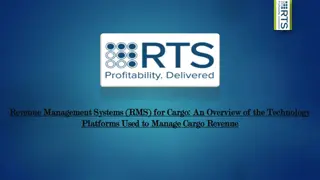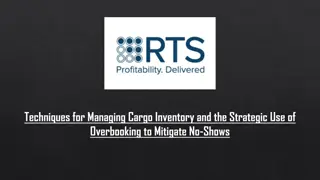Cargo Securement and Safety Training Overview
This content provides comprehensive information on cargo securement and safety training for Class 1 drivers. It covers topics such as cargo regulations, handling cargo, loading and inspection procedures, types of cargo, securement requirements, weight distribution, driver responsibilities, theft prevention, and personal safety. The importance of cargo inspection, documentation, and various securement systems and devices is highlighted to ensure the safe transportation of goods.
Download Presentation

Please find below an Image/Link to download the presentation.
The content on the website is provided AS IS for your information and personal use only. It may not be sold, licensed, or shared on other websites without obtaining consent from the author.If you encounter any issues during the download, it is possible that the publisher has removed the file from their server.
You are allowed to download the files provided on this website for personal or commercial use, subject to the condition that they are used lawfully. All files are the property of their respective owners.
The content on the website is provided AS IS for your information and personal use only. It may not be sold, licensed, or shared on other websites without obtaining consent from the author.
E N D
Presentation Transcript
MELT Class 1 Driver Training Cargo securement and security
Lesson overview Cargo regulations Handling cargo Cargo loading and inspection Types of cargo Securement requirements Weight distribution and load limits Driver responsibilities Cargo theft and security Personal safety 2
Securement regulations Regulations require you to secure the following equipment: Cargo must be loaded onto a vehicle so that it does not: Tailgates Tailboards Doors Tarps Spare tires Obscure your vision Interfere with your control of the vehicle Block access to emergency equipment Make it difficult for you or a passenger to get out of the vehicle Your vision and vehicle access must not be blocked Documentation is important. 4
Securement systems A cargo securement system combines the use of one or combination of the following components: Vehicle structure Securing devices Blocking and bracing equipment Dunnage Load locking bars Tarps 5
Securement systems - tiedowns You may use tiedowns to produce only downward force, to provide restraint in a single direction or to provide restraint in several directions at the same time. 6
Securing freight in vans E Track Dunnage Friction mats Jack bars 9
Working load limit (WLL) The total working load limit of any cargo securement system must be at least half of the weight of the load being secured. 11
Securement systems - three ways to secure cargo on or within a vehicle Immobilize Restrain Contain 12
Weight distribution On every trip, you need to know: the legal weight of the tractor-trailer, the overall length of the vehicle, the weight allowed per axle, and all federal, provincial and municipal laws and restrictions. 13
Specific commodities securement The next set of slides covers: Logs Dressed lumber Metal coils Paper rolls Concrete pipe Intermodal containers Large boulders Dry bulk and liquid tanks Vehicles (small, large, crushed) Crushed vehicles Roll-on/roll-off or hook lift container Covering cargo 14
Logs 15
Metal coils 17
Paper rolls 18
Boulders 21
Vehicles 23
Load securement incident scenarios In your groups, read your assigned scenario and discuss the questions in your workbook. Come back prepared to present your scenario and findings. 26
Cargo theft and security Cargo security is a major part of a professional driver s job. Every year, millions of dollars in cargo and equipment are stolen. 27
Cargo security continued CBC News Radio Merchandise on wheels: why thieves are stealing cargo trucks (7:16) https://www.cbc.ca/news/canada/hamilton/cargo-truck- thefts-1.5278924 28
Tips to prevent cargo theft 1. Understand how cargo theft happens. 2. Make sure your employer provides training and education. 3. Pay attention to your surroundings. 4. Keep your freight moving. 5. Do some research and plan. 6. Use technology and other safety measures. Tips to prevent cargo theft on the road https://www.youtube.com/watch?v=HXuSm0AgEwc 29
Recognize it and report it Help IBC fight cargo theft across Canada. To report stolen cargo: Make an anonymous phone call to 1-877-IBC-TIPS (422-8477), which operates day and night. Complete and submit an anonymous Cargo Theft Incident Report Form Contact an IBC Consumer Information Officer 30























